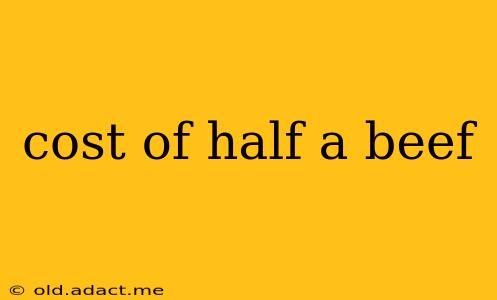The Cost of Half a Beef: A Comprehensive Guide
Buying half a beef can be a significant undertaking, offering substantial savings compared to purchasing individual cuts at the grocery store. However, the total cost depends on several factors, making it crucial to understand what influences the final price. This comprehensive guide breaks down the cost of half a beef, addressing common questions and concerns.
What are the factors that determine the price of half a beef?
Several key factors contribute to the overall cost of a half beef. These include:
- Breed and weight of the animal: Different breeds of cattle have varying market values. Larger animals naturally yield more meat, influencing the price per pound. Premium breeds often command higher prices.
- Processing fees: This encompasses the cost of slaughtering, butchering, and packaging the beef. These fees can vary widely depending on the processing facility and the specific services requested (e.g., custom cuts, vacuum sealing).
- Location: Geographic location significantly impacts prices. Rural areas may have lower processing fees compared to urban areas, while the cost of the animal itself might fluctuate regionally based on supply and demand.
- Time of year: Seasonal variations can impact the cost of livestock. Demand might increase during holidays, driving up prices.
- Type of processing: Choosing a local butcher versus a larger commercial processor affects the cost. A local butcher often charges a premium for personalized service and specific cuts.
- Additional services: Additional costs might include transportation to the processing facility, aging of the meat, or specialized packaging.
How much does half a beef typically cost?
Providing an exact figure is difficult, as prices fluctuate considerably. However, a reasonable estimate for the cost of a half beef, including processing, ranges from $800 to $2000 or more. This significant range underscores the impact of the factors discussed above. It's essential to get multiple quotes from different processors and farmers to compare prices.
What is included in the price of half a beef?
When you purchase half a beef, you typically receive roughly half of the usable carcass weight. This usually includes a variety of cuts, such as:
- Roasts: Chuck roast, rib roast, sirloin roast
- Steaks: Ribeye, sirloin, T-bone, New York strip
- Ground beef: A significant portion will be ground beef.
- Stewing meat: Such as chuck or shank meat, ideal for soups and stews.
- Other cuts: Such as short ribs, brisket, and various other cuts depending on the butcher's preferences and your specifications.
How much beef do you get from half a beef?
The amount of meat you receive from half a beef varies depending on the size of the animal. A standard beef carcass weighs around 600-800 pounds, meaning half a beef could yield approximately 300-400 pounds of usable meat. However, this is an approximation, and the actual amount can be higher or lower.
Where can I buy half a beef?
Several options exist for purchasing half a beef:
- Local farmers: Contacting local farmers directly often offers the best prices and allows for greater transparency regarding the animal's history and treatment.
- Meat processors: Many meat processors work with farmers and can connect you with livestock.
- Online marketplaces: Some online platforms specialize in connecting consumers with farmers and ranchers.
How to choose the right provider for buying half a beef?
Thorough research is vital before making a purchase. Ask potential providers about:
- Animal sourcing: Inquire about the breed, age, and feeding practices of the cattle.
- Processing fees: Obtain a detailed breakdown of all processing costs.
- Payment terms: Understand payment schedules and any required deposits.
- Delivery options: Confirm how and when the meat will be delivered.
- Storage: Consider your freezer capacity and whether you need to make arrangements for additional cold storage.
Buying half a beef is a considerable investment that offers potential long-term savings and high-quality meat. By carefully considering the factors outlined above and conducting thorough research, you can make an informed decision and enjoy the benefits of this approach to meat purchasing.
